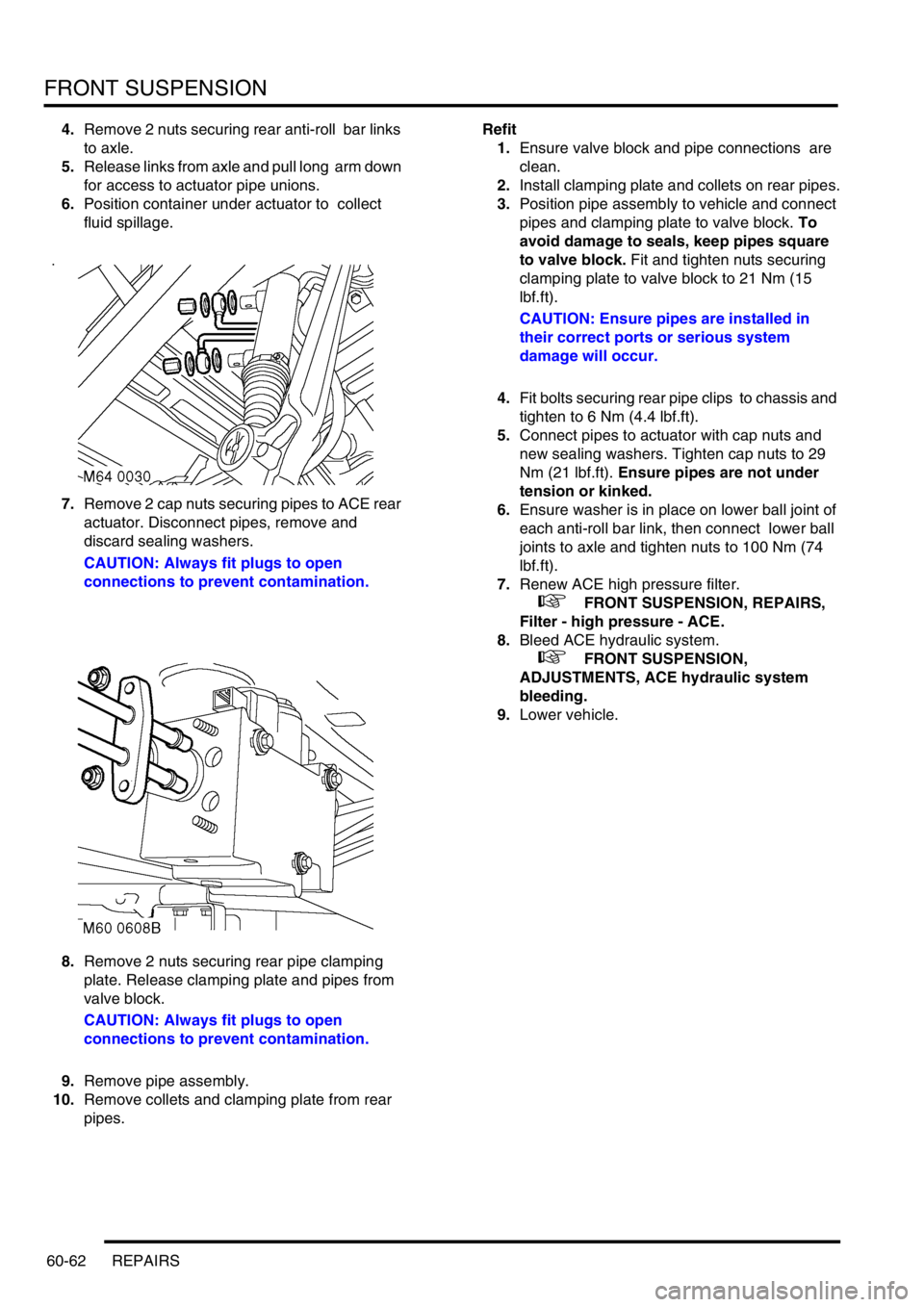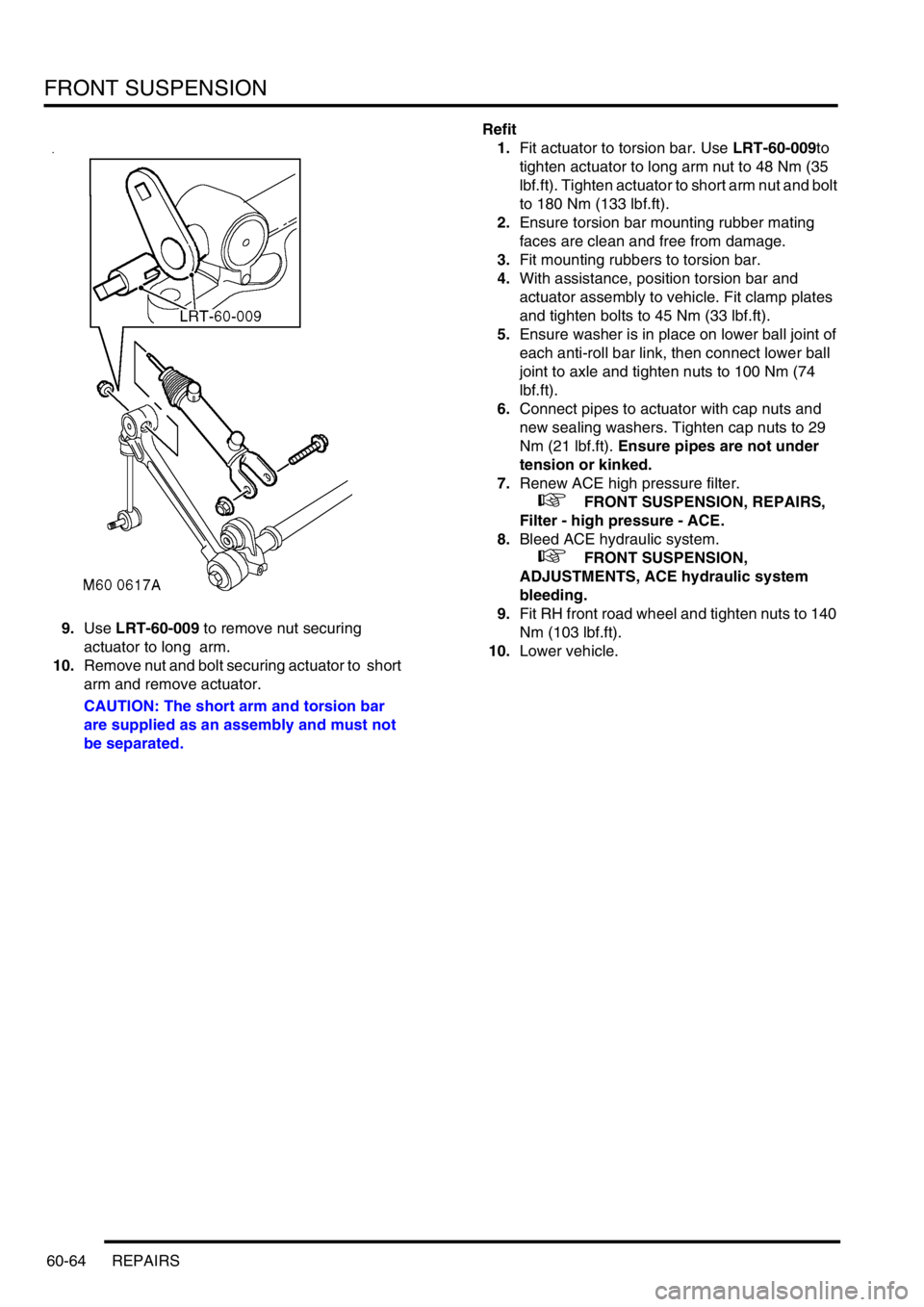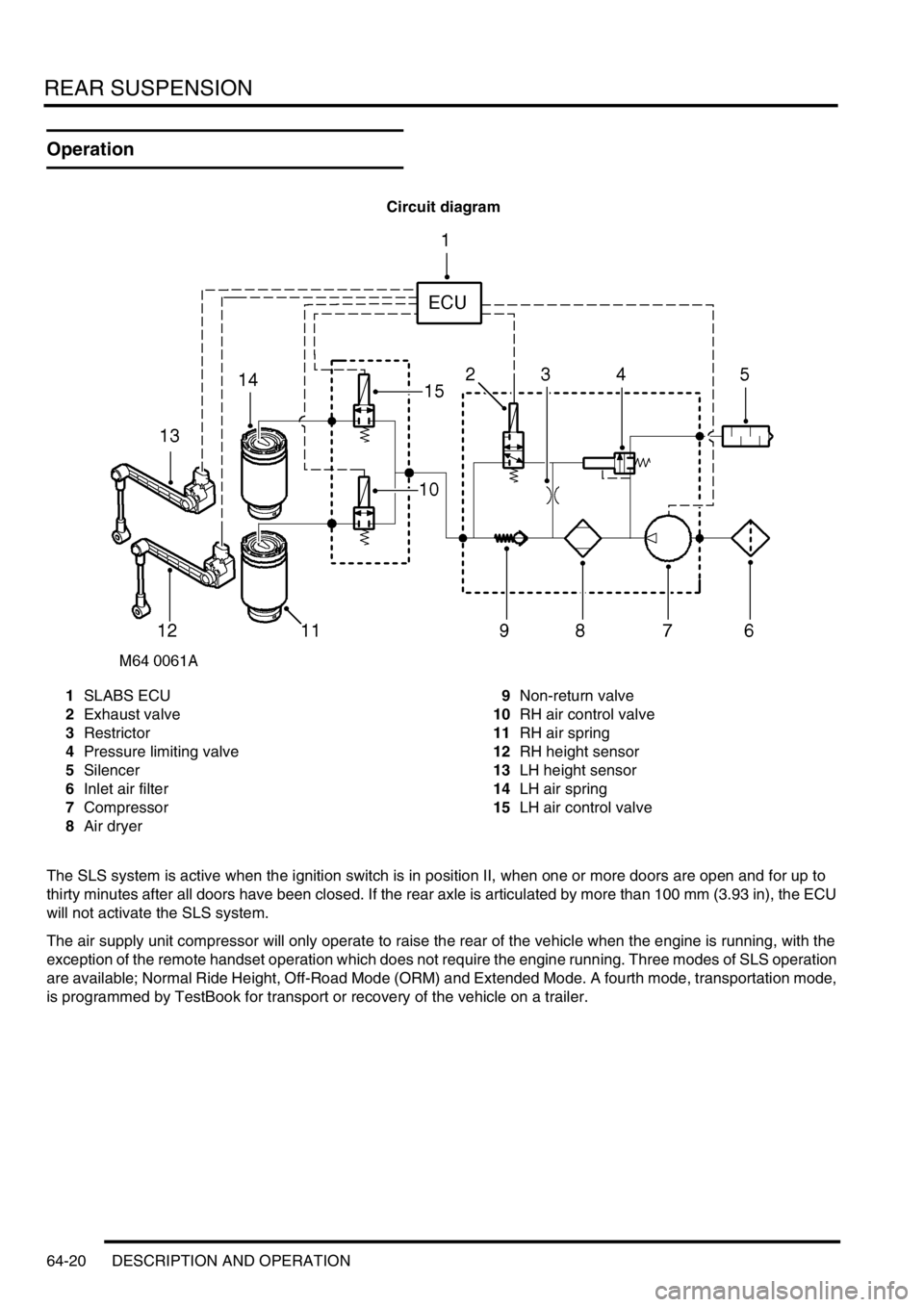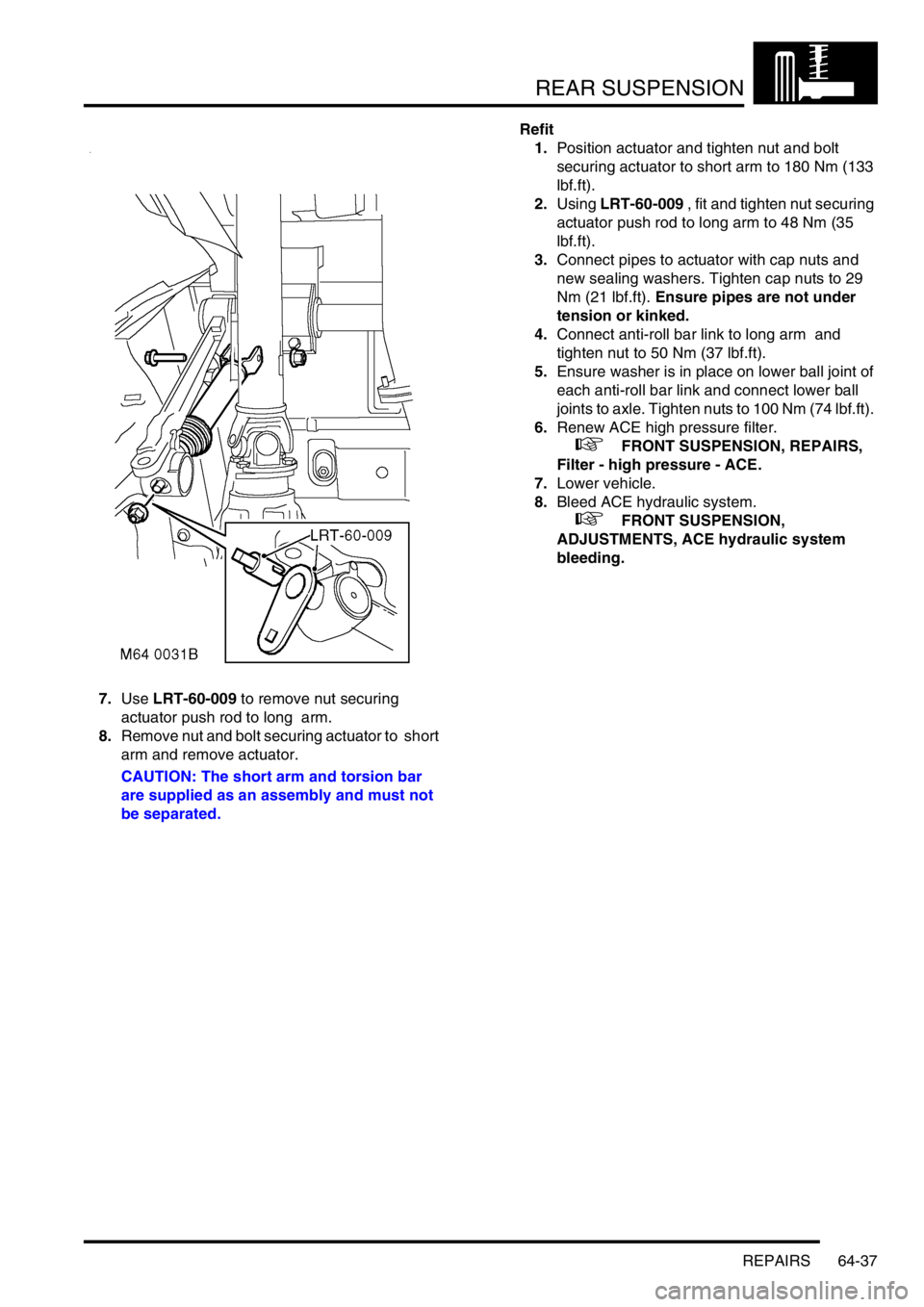Page 1000 of 1672

FRONT SUSPENSION
REPAIRS 60-61
7.Fit pipe clamps to pipes, align clamps to
chassis front cross member and fit bolts.
8. Valve block to reservoir pipe: F it pi pe to c li p
on LH chassis member.
9.Fit pipe clamp to pipes, align clamp to
suspension turret and secure with nut.
10.Fit pipe clamp to pipes, align clamp to RH
chassis member and secure with bolt.
11.Align and secure harness to suspension turret.
12.Fit thermostat housing and hoses and secure
hoses with clips.
13.Fit turbocharger outlet pipe and secure hoses
with clips.
14.Connect turbocharger pressure sensing hose
and secure with clip.
15.Fit 'O' ring to air cleaner.
16.Fit air hose to turbocharger and tighten clip.
17.Fit air flow meter to air cleaner and secure with
clips.
18.Connect multiplug to air flow meter.
19.Fit lower half of fan cowl and secure with
screws.
20.Fit viscous fan.
+ COOLING SYSTEM - Td5, REPAIRS,
Fan - viscous.
21.Fit RH splash shield and secure with screws.
22.Fit road wheel.
23.Fit valve block.
+ FRONT SUSPENSION, REPAIRS,
Valve block - ACE.
24.Renew ACE high pressure filter
+ FRONT SUSPENSION, REPAIRS,
Filter - high pressure - ACE.
25.Lower vehicle.
26.Fill cooling system.
+ COOLING SYSTEM - Td5,
ADJUSTMENTS, Drain and refill.
Pipe assembly - valve block to rear
actuator - ACE
$% 60.60.33
CAUTION: The ACE hydraulic system is
extremely sensitive to the ingress of dirt or
debris. The smallest amount could render the
system unserviceable. It is imperative that the
following precautions are taken.
lACE components are thoroughly cleaned
externally before work commences;
lall opened pipe and module ports are
capped immediately;
lall fluid is stored in and administered
through clean containers.
Remove
1.Raise vehicle on a ramp.
2.Position container under valve block to collect
fluid spillage.
3.Remove 2 bolts securing 2 rear pipe clips to
chassis.
Page 1001 of 1672

FRONT SUSPENSION
60-62 REPAIRS
4.Remove 2 nuts securing rear anti-roll bar links
to axle.
5.Release links from axle and pull long arm down
for access to actuator pipe unions.
6.Position container under actuator to collect
fluid spillage.
7.Remove 2 cap nuts securing pipes to ACE rear
actuator. Disconnect pipes, remove and
discard sealing washers.
CAUTION: Always fit plugs to open
connections to prevent contamination.
8.Remove 2 nuts securing rear pipe clamping
plate. Release clamping plate and pipes from
valve block.
CAUTION: Always fit plugs to open
connections to prevent contamination.
9.Remove pipe assembly.
10.Remove collets and clamping plate from rear
pipes. Refit
1.Ensure valve block and pipe connections are
clean.
2.Install clamping plate and collets on rear pipes.
3.Position pipe assembly to vehicle and connect
pipes and clamping plate to valve block. To
avoid damage to seals, keep pipes square
to valve block. Fit and tighten nuts securing
clamping plate to valve block to 21 Nm (15
lbf.ft).
CAUTION: Ensure pipes are installed in
their correct ports or serious system
damage will occur.
4.Fit bolts securing rear pipe clips to chassis and
tighten to 6 Nm (4.4 lbf.ft).
5.Connect pipes to actuator with cap nuts and
new sealing washers. Tighten cap nuts to 29
Nm (21 lbf.ft). Ensure pipes are not under
tension or kinked.
6.Ensure washer is in place on lower ball joint of
each anti-roll bar link, then connect lower ball
joints to axle and tighten nuts to 100 Nm (74
lbf.ft).
7.Renew ACE high pressure filter.
+ FRONT SUSPENSION, REPAIRS,
Filter - high pressure - ACE.
8.Bleed ACE hydraulic system.
+ FRONT SUSPENSION,
ADJUSTMENTS, ACE hydraulic system
bleeding.
9.Lower vehicle.
Page 1003 of 1672

FRONT SUSPENSION
60-64 REPAIRS
9.Use LRT-60-009 to remove nut securing
actuator to long arm.
10.Remove nut and bolt securing actuator to short
arm and remove actuator.
CAUTION: The short arm and torsion bar
are supplied as an assembly and must not
be separated.Refit
1.Fit actuator to torsion bar. Use LRT-60-009to
tighten actuator to long arm nut to 48 Nm (35
lbf.ft). Tighten actuator to short arm nut and bolt
to 180 Nm (133 lbf.ft).
2.Ensure torsion bar mounting rubber mating
faces are clean and free from damage.
3.Fit mounting rubbers to torsion bar.
4.With assistance, position torsion bar and
actuator assembly to vehicle. Fit clamp plates
and tighten bolts to 45 Nm (33 lbf.ft).
5.Ensure washer is in place on lower ball joint of
each anti-roll bar link, then connect lower ball
joint to axle and tighten nuts to 100 Nm (74
lbf.ft).
6.Connect pipes to actuator with cap nuts and
new sealing washers. Tighten cap nuts to 29
Nm (21 lbf.ft). Ensure pipes are not under
tension or kinked.
7.Renew ACE high pressure filter.
+ FRONT SUSPENSION, REPAIRS,
Filter - high pressure - ACE.
8.Bleed ACE hydraulic system.
+ FRONT SUSPENSION,
ADJUSTMENTS, ACE hydraulic system
bleeding.
9.Fit RH front road wheel and tighten nuts to 140
Nm (103 lbf.ft).
10.Lower vehicle.
Page 1014 of 1672
REAR SUSPENSION
DESCRIPTION AND OPERATION 64-9
DESCRIPTION AND OPERAT ION
SLS component layout
RH drive shown, LH drive similar
1Off-road mode switch
2SLS warning lamp
3Instrument pack
4Off-road mode warning lamp
5RH Height sensor
6RH Air spring
7Air inlet filter
8LH Air spring
9LH Height sensor
10Air supply unit
11SLABS ECU
Page 1019 of 1672

REAR SUSPENSION
64-14 DESCRIPTION AND OPERATION
The air supply unit comprises a 12 V electric motor, a compressor and air dryer unit, a pressure limiting valve, an
exhaust valve and two air supply control valves. The exhaust and control valves are solenoid operated responding to
signals from the SLABS ECU. The electric motor, compressor, air dryer and pressure limiting and exhaust valve are
mounted on flexible rubber mountings to reduce operating noise.
The electric motor drives a crank with an eccentric pin to which a connecting rod is attached. The connecting rod has
a piston which fits in the bore of the compressor. Operation of the motor rotates the crank, moving the piston in the
bore of the compressor.
The compressor is attached with Allen bolts to the motor housing and sealed with an O-ring. Attached to the
compressor is the air dryer which contains a silicate box for removing moisture from the compressed air. Air supplied
to inflate the air springs passes through the air dryer. When the air springs are deflated, the exhaust air also passes
through the air dryer, removing the moisture from the unit and expelling it to atmosphere.
Attached to end of the air dryer unit is the pressure limiting valve. The valve protects the air springs from over inflation.
The pressure limiting valve also operates when the exhaust valve is opened. The valve is pneumatically operated,
responding to air pressure applied to it.
The exhaust valve is also located with the pressure limiting valve. The exhaust valve is solenoid operated by the ECU
and directs air from the air springs and control valves to atmosphere when required.
The two air control valves for the LH and RH air springs are located at the forward end of the housing. Each valve is
connected to the compressor/air dryer unit through a shared single pipe which directs air to and from the air springs.
Each control valve is individually operated by the ECU.
All air connections to and from the air supply unit are made through the SLS air harness which is located along the
left hand chassis longitudinal.
If faults occur with the air supply unit, fault codes are stored in the SLABS ECU. These fault codes cover the
compressor power supply and the LH and RH air control valves and the exhaust valve. The current and past fault
codes can be retrieved with TestBook. TestBook can also be used to operate the compressor and the valves for
diagnostic purposes.
Air intake filter
The air intake filter is located in the left hand 'E' post, behind the tail lamp assembly. The filter comprises a plastic
moulded housing which contains two filters of differing density to remove particulate matter from the air drawn in by
the compressor. The air intake filter has a pipe which is connected to the SLS air harness by a quick release
connector. The air intake filter must be replaced as an assembly.
Air intake/Exhaust silencer
The air intake/exhaust silencer is located on the outside of the left hand chassis longitudinal, behind the air supply
unit. The silencer is an integral part of the SLS air harness and cannot be serviced individually.
The intake and exhaust air to and from the compressor passes through the silencer. The plastic moulded silencer has
two chambers. One chamber reduces system exhaust noise and the other dampens intake air pulses produced by
the compressor.
Page 1025 of 1672

REAR SUSPENSION
64-20 DESCRIPTION AND OPERATION
Operation
Circuit diagram
1SLABS ECU
2Exhaust valve
3Restrictor
4Pressure limiting valve
5Silencer
6Inlet air filter
7Compressor
8Air dryer9Non-return valve
10RH air control valve
11RH air spring
12RH height sensor
13LH height sensor
14LH air spring
15LH air control valve
The SLS system is active when the ignition switch is in position II, when one or more doors are open and for up to
thirty minutes after all doors have been closed. If the rear axle is articulated by more than 100 mm (3.93 in), the ECU
will not activate the SLS system.
The air supply unit compressor will only operate to raise the rear of the vehicle when the engine is running, with the
exception of the remote handset operation which does not require the engine running. Three modes of SLS operation
are available; Normal Ride Height, Off-Road Mode (ORM) and Extended Mode. A fourth mode, transportation mode,
is programmed by TestBook for transport or recovery of the vehicle on a trailer.
Page 1039 of 1672
REAR SUSPENSION
64-34 REPAIRS
Filter - intake - SLS
$% 64.50.12
Remove
1.Remove LH tail lamp.
+ LIGHTING, REPAIRS, Lamp - tail.
2.Disconnect filter from retaining peg.
3.Disconnect quick release connection and
remove filter assembly.
Refit
1.Position filter assembly and connect quick
release connection.
2.Secure filter retaining peg.
3.Fit LH tail lamp.
+ LIGHTING, REPAIRS, Lamp - tail.
Switch - ride height
$% 64.50.45
Remove
1.Carefully remove switch.
2.Disconnect multiplug from switch.
3.Remove switch.
Refit
1.Connect multiplug switch.
2.Position switch and push to secure.
Page 1042 of 1672

REAR SUSPENSION
REPAIRS 64-37
7.Use LRT-60-009 to remove nut securing
actuator push rod to long arm.
8.Remove nut and bolt securing actuator to short
arm and remove actuator.
CAUTION: The short arm and torsion bar
are supplied as an assembly and must not
be separated.Refit
1.Position actuator and tighten nut and bolt
securing actuator to short arm to 180 Nm (133
lbf.ft).
2.Using LRT-60-009 , fit and tighten nut securing
actuator push rod to long arm to 48 Nm (35
lbf.ft).
3.Connect pipes to actuator with cap nuts and
new sealing washers. Tighten cap nuts to 29
Nm (21 lbf.ft). Ensure pipes are not under
tension or kinked.
4.Connect anti-roll bar link to long arm and
tighten nut to 50 Nm (37 lbf.ft).
5.Ensure washer is in place on lower ball joint of
each anti-roll bar link and connect lower ball
joints to axle. Tighten nuts to 100 Nm (74 lbf.ft).
6.Renew ACE high pressure filter.
+ FRONT SUSPENSION, REPAIRS,
Filter - high pressure - ACE.
7.Lower vehicle.
8.Bleed ACE hydraulic system.
+ FRONT SUSPENSION,
ADJUSTMENTS, ACE hydraulic system
bleeding.